The Best of Creative Computing Volume 1 (published 1976)
How to Cope With Your Computer (frustration, flowcharts)

How To Cope With Your Computer
Susan S. Most
Cape Elizabeth High School, ME
It cannot think. It's just a big metal box with a mess of wires inside and a
myriad of lights continually flashing on and off. Ingenious device that it is,
that box is capable of solving infinitely complicated problems in less time than
one's lips can say "computerman". Alas, but if you don't know how to operate it,
you might as well take it to the dump.
One cannot imagine the sheer frustration a person feels when faced with the
task of operating a computer for the first time. You're standing in a room where
people look disgustingly productive with yards of yellow paper spewing from
their teletypes. A continuous clicking, clicking noise comes at your ears in
such an important and official manner that you shiver a bit at the idea that
perhaps someday you might be in charge of one of these "things". Your feeling of
impending importance is burst like the rush of air from a pin-pricked balloon.
You can't even read what it prints, to say nothing of telling it what to do.
Bits of incomprehensible brilliance flow forth each fraction of a second as the
carriage on the teletype races back and forth; and the lights on the front panel
merrily wink at your ignorance.
It's not a question of just saying in plain English what fantastic chore you
want it to perform - this "box" doesn't understand plain English. Since the box
really has no ”brain" inside - only wires; the operator must learn "the
tongue" that it does understand. This code includes such startlingly clear terms
as TAD, DCA, JMS, etc., and those are cinchy compared to 7402 and, how's this-
ready: 111 000 010 101. Imagine a number like that meaning something to anybody.
Ridiculous, you think? Well, to the box it's crystal clear. That is, of course,
assuming you're using a computer that understands that language. To add another
fly to the ointment, there are many languages which are not interchangeable with
machines designed by other companies.
The most helpful tool to the harried individual attempting to coexist with a
computer is a diagram called a "flowchart". It's not a plumber's helper nor a
sea captain's guide. Rather, a flowchart is a way to clarify on paper exactly
what sequence of calculations you want the computer to carry out. At the same
time it helps you chart your train of thought, assuming of course there is some
flow to your ideas.
Once the flowchart has been written, don't think telling the computer to follow
it will be a cinch - that's the hardest part. Being a brainless genius, the
computer must be told exactly, in the correct order, what to do. Coding is not
the language of martians, but an analyst's shorthand - usually the initials of
processes one wants the computer to do.
Yet understanding a code and having written a flowchart still cannot guarantee
success. Writing a program containing all the operations to get the correct
answer can cause such frustration that one could be driven to his nearest
analyst – in psychoanalysis, that is. This novice programmer nearly climbed a
flagpole trying to think "like the box". Take heart, however, eventually you
win.


